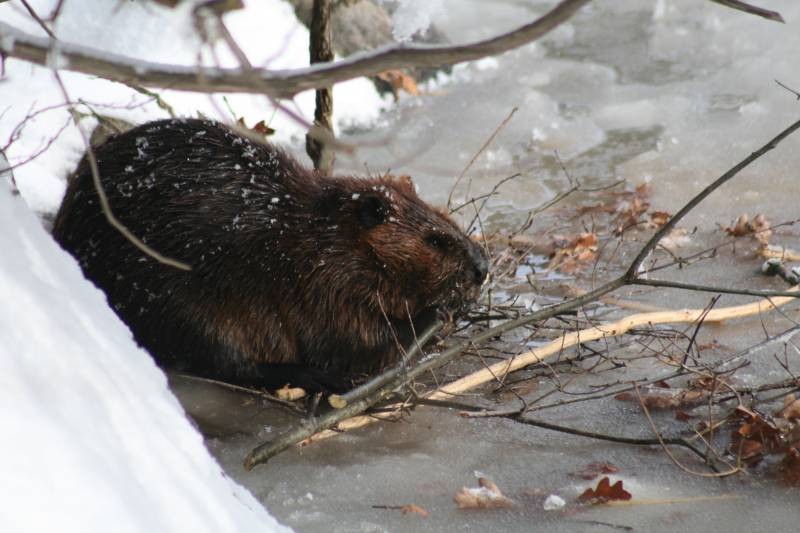HENRY TAYLOR – A Legend in His Own Time
In November of 1999 Henry Taylor, then 95, received recognition from the Ontario Museum Association as Bancroft’s Citizen of the Century. At the same time the iconic outdoorsman also received the association’s Lifetime Achievement Award of Merit. “It was a great shock to my nervous system,” Henry later wrote in a card of thanks.
Born September 19, 1904, Henry became both a living historian and history itself. Although a living legend Henry, at a little over five foot, more resembled a mischievous woodland elf; although historically he cast a giant’s shadow.
Henry’s vivid memory of dates, names, concession numbers.. was uncanny. When I joked that he was making up the stories that he told me because all of the witnesses were deceased he would just respond with his impish smile. Betty, his daughter-in-law, happened to be passing nearby and responded, “Yes, that may be but Henry’s stories are always consistent.”
Literally Henry was a man of the forest having lived his entire life in the bush and so it is somewhat ironic, when we trace his ancestry, to discover that his great-great grandfather in Scotland was named Don Forest. Begging one to ask, “What’s in a name?”
Forest, by the way, lived to be 96. “I have to go one more year to catch up to him,” Henry chuckled. “We Taylors are in the habit of living a good long time.”
Henry’s Canadian lineage consists of both Taylors and Stringers.
The Stringers Come to Canada
John and Bill Stringer were the first Stringers in Henry’s lineage to emigrate to Canada. At age 14 John worked as a cabin boy on a trading ship. His older brother Bill was an Able Body sailor on that same ship. Indians would trade furs for items such as muskets. One musket, standing on its butt, would be traded for a pile of beaver pelts of equal height. For example, if the musket was three feet tall the equivalent pile of pelts would be three feet tall.
At some point John ran afoul of the ship’s captain and for that he received a beating. Normally noone would interfere but the captain used a knotted rope and beat him unmercifully. Bill Stringer, unable to stand by, interfered and lay a beating upon the captain. Had this been a ship of war Bill would have been tried for mutiny and hanged. As this was a trading vessel Bill knew that in time the captain would have his revenge.
In preparation for the return voyage to England the captain sent a boat ashore for fresh water. Bill Stringer was in that boat. After they filled the water barrels Bill, not wishing to risk his neck being stretched, deserted. “That was in the summer of 1819,” said Henry. John Stringer was still on board.
As it was a particularly hot August the captain, to escape the oppressive heat on-board, towed a little boat behind the ship where he would sleep at night.
“Evidently there were people on that ship who didn’t have any more use for the captain than the Stringer lads,” said Henry, “for someone cut that boat loose.”
When the morning lookout reported the boat missing they had no choice but to return and search for the captain or chance being hanged in England for piracy. As it happened they picked up the captain between Montreal and Quebec near the north shore of the St. Lawrence.
“As soon as the captain came on board he blamed John Stringer and was going to finish murdering him right off quick so he dove overboard and that’s how the Stringers came to Canada from Scotland.”
John’s Journey
John Stringer hid under some piles of lumber to avoid the search party which, according to Henry Taylor, didn’t look very hard for they feared for the boy’s life and thus returned to the ship empty handed.
Soaking wet, owning nothing but the clothing on his back and unable to speak a word of French young John made his way along the river begging for food and shelter on his way to Montreal.
In Montreal John fell in with a gang of men going to Bytown (Ottawa) to clear land and build cabins for a tourist venture. Stringer hired on with a man named Sparks (Sparks street?) and passed the winter of 1819/20 in Bytown where he was befriended by some Indians who taught him how to trap.
John Stinger managed to trap some very valuable silver fox. However Sparks, as it turned out, was the “same brand as the ship’s captain”, for he confiscated young Stringer’s furs claiming that the boy was not entitled to them as he was in Spark’s employ and didn’t have Spark’s permission to trap.
According to Henry, John Stringer “fell out real quick with Sparks like he did with the ship’s captain and left his employ in the spring of 1820.”
“Because he claimed to have no money to pay the boy for his services Sparks offered him some land and a cabin. Mad and disgusted, Stringer turned his back and walked away.”
According to Henry Taylor that piece of land and cabin sat on a knoll presently occupied by Canada’s parliament buildings.
At this time Peter MacIntyre and his family were passing through Bytown on their way to Arnprior to settle in McNab Township and John Stringer joined them. John later married Peter’s daughter Catherine and their eldest son Joe was destined to become Henry Taylor’s maternal grandfather.
In the meantime what had become of brother Bill?
